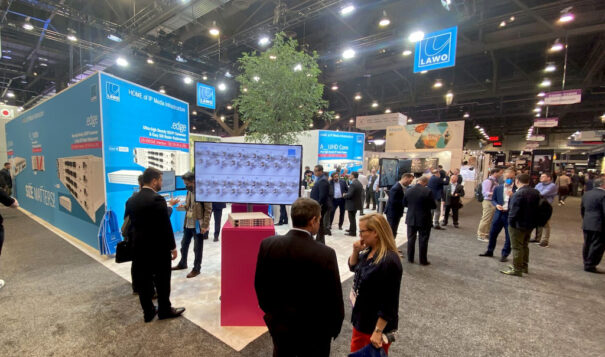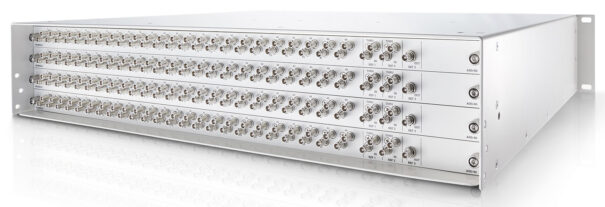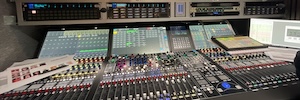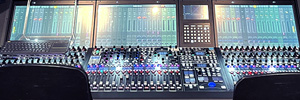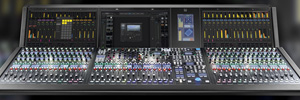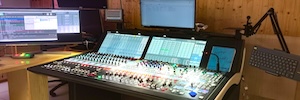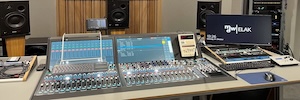Lawo estrena en NAB 2022 .edge, un procesador IP de próxima generación compatible con entornos SDI
.edge, un procesador de próxima generación pensado para ser completamente versátil en entornos IP al tiempo que ayuda a transicionar desde el SDI, es la gran apuesta de Lawo for NAB 2022.
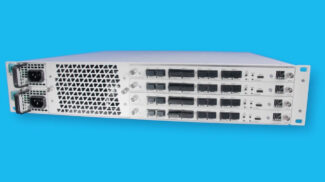 La compacta carcasa de 2RU of .edge aloja hasta cuatro blades de procesamiento .edge de 25/100 GbE. Cada una de sus placas E/S traseras proporciona 48 conectores HD-BNC para la interconexión SDI SD/HD/3G/UHD, lo que da como resultado 192 conversiones SDI/IP por cada 2RU. .edge proporciona soporte completo para el conjunto de estándares SMPTE ST2110 con redundancia ST2022-7 incorporada, proporcionando no sólo un manejo avanzado basado en la esencia, sino también asegurando una conmutación de protección sin fisuras de los flujos de audio, vídeo y datos auxiliares en las operaciones de red tanto locales como de área amplia.
La compacta carcasa de 2RU of .edge aloja hasta cuatro blades de procesamiento .edge de 25/100 GbE. Cada una de sus placas E/S traseras proporciona 48 conectores HD-BNC para la interconexión SDI SD/HD/3G/UHD, lo que da como resultado 192 conversiones SDI/IP por cada 2RU. .edge proporciona soporte completo para el conjunto de estándares SMPTE ST2110 con redundancia ST2022-7 incorporada, proporcionando no sólo un manejo avanzado basado en la esencia, sino también asegurando una conmutación de protección sin fisuras de los flujos de audio, vídeo y datos auxiliares en las operaciones de red tanto locales como de área amplia.
Phil Myers, CTO de Lawo, aporta más detalles de la solución presentada en NAB 2022: “.edge complementa la solución establecida de procesamiento de vídeo y multiviewer V__matrix de Lawo con una pasarela SDI/IP de hiperdensidad. Está diseñada desde el principio para ser un cliente nativo de Home. Se descubre y registra automáticamente dentro de nuestro entorno de red Home y se beneficia de todas las funciones de gestión de nueva generación de Home: control de acceso de usuarios, cuarentena de dispositivos desconocidos, seguridad de la red, ajuste de parámetros y supervisión de la salud en tiempo real”.
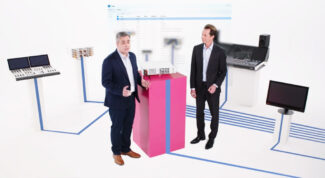 Una propuesta inédita ampliable por software
Una propuesta inédita ampliable por software
El diseño de la placa de .edge es único: no tiene un bus TDM de audio, ni una matriz de vídeo en medio de su arquitectura. El vídeo se conmuta en el nivel de paquetes IP “make before break” (MBB) o “break before make” (BBM). Las señales de audio se conmutan en el modo MBB utilizando una curva de desvanecimiento en V para lograr transiciones limpias y silenciosas. La compatibilidad con el bucle local de .edge permite a los usuarios encaminar las entradas locales a las salidas locales, mientras que la capacidad de replicación de paquetes permite que un paquete recibido una vez pueda ser utilizado muchas veces sin necesidad de operaciones adicionales de gestión de flujos o de lógica: los paquetes del búfer de paquetes están disponibles para cualquier salida SDI.
 Diseñado como infraestructura licenciable por software, .edge puede ofrecer “la máxima flexibilidad OPEX” para una herramienta basada en hardware. Cada blade de .edge puede utilizarse en una gran variedad de escenarios simplemente desbloqueando los conjuntos de características necesarios a través de un sistema de licencias flexible. Además de su licencia básica para el uso de 16 conectores BNC, existen opciones para desbloquear E/S adicionales hasta sus 48 BNC completos. Existen licencias de funciones adicionales para los sincronizadores de tramas de entrada, la activación de puertos de 100GbE y el engranaje UHD 3G, incluida la función exclusiva de Lawo “UHD Link Rotate”. Esta función reordena automáticamente los tramos de un enlace 3G-SDI de cuatro hilos cuyos cables estaban conectados en el orden equivocado.
Diseñado como infraestructura licenciable por software, .edge puede ofrecer “la máxima flexibilidad OPEX” para una herramienta basada en hardware. Cada blade de .edge puede utilizarse en una gran variedad de escenarios simplemente desbloqueando los conjuntos de características necesarios a través de un sistema de licencias flexible. Además de su licencia básica para el uso de 16 conectores BNC, existen opciones para desbloquear E/S adicionales hasta sus 48 BNC completos. Existen licencias de funciones adicionales para los sincronizadores de tramas de entrada, la activación de puertos de 100GbE y el engranaje UHD 3G, incluida la función exclusiva de Lawo “UHD Link Rotate”. Esta función reordena automáticamente los tramos de un enlace 3G-SDI de cuatro hilos cuyos cables estaban conectados en el orden equivocado.
Una opción para saltar del SDI al IP
Para facilitar la sustitución del enrutador SDI, los paquetes .edge of Lawo están disponibles para capacidades de matriz de 288 x 288, 576 x 576 and 1152 x 1152. Se completan con los conmutadores de red que elija el cliente y una licencia HOME. Para los sistemas de control de emisión, el paquete .edge/HOME se comporta como un router SDI tradicional, lo que significa que no hay cambios en las interfaces de usuario ni en los flujos de trabajo. Esto permite a los broadcasters mantener todo su equipo SDI existente en funcionamiento.
Andreas Hilmer, director de marketing de Lawo, detalla las claves que hacen a esta solución válida para aquellos broadcasters que planean el salto al IP a medio plazo: “Después de migrar a una solución de sustitución del router .edge/HOME, tiene un router SDI que puede escalar según sus necesidades. Si sus necesidades crecen, sólo tiene que conectar más E/S .edge a su conmutador de red. Dado que su sistema de enrutamiento principal se basa ahora en IP, su enrutador no tiene que permanecer como un monolito en un solo lugar. Puede estar distribuido por toda la instalación. Coloque las E/S donde se necesiten y ahorre importantes costes de cableado. Los usuarios pueden distribuir su infraestructura de enrutamiento .edge por varias instalaciones, por todo el país o incluso por continentes”.
Did you like this article?
Subscribe to us RSS feed And you will not miss anything.



